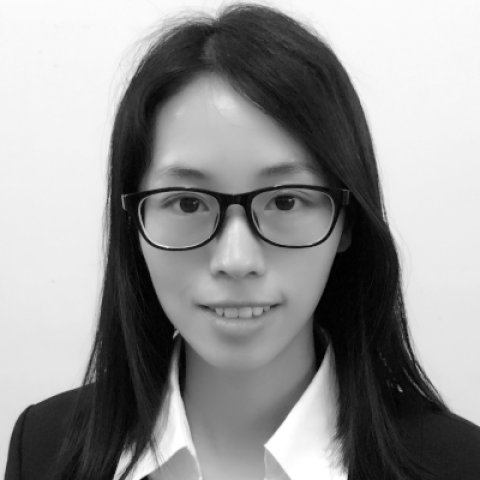Labelexpo Asia 2023 showcases vibrant Chinese industry
Labelexpo Asia 2023 showcased a vibrant Chinese manufacturing industry along with key international suppliers.
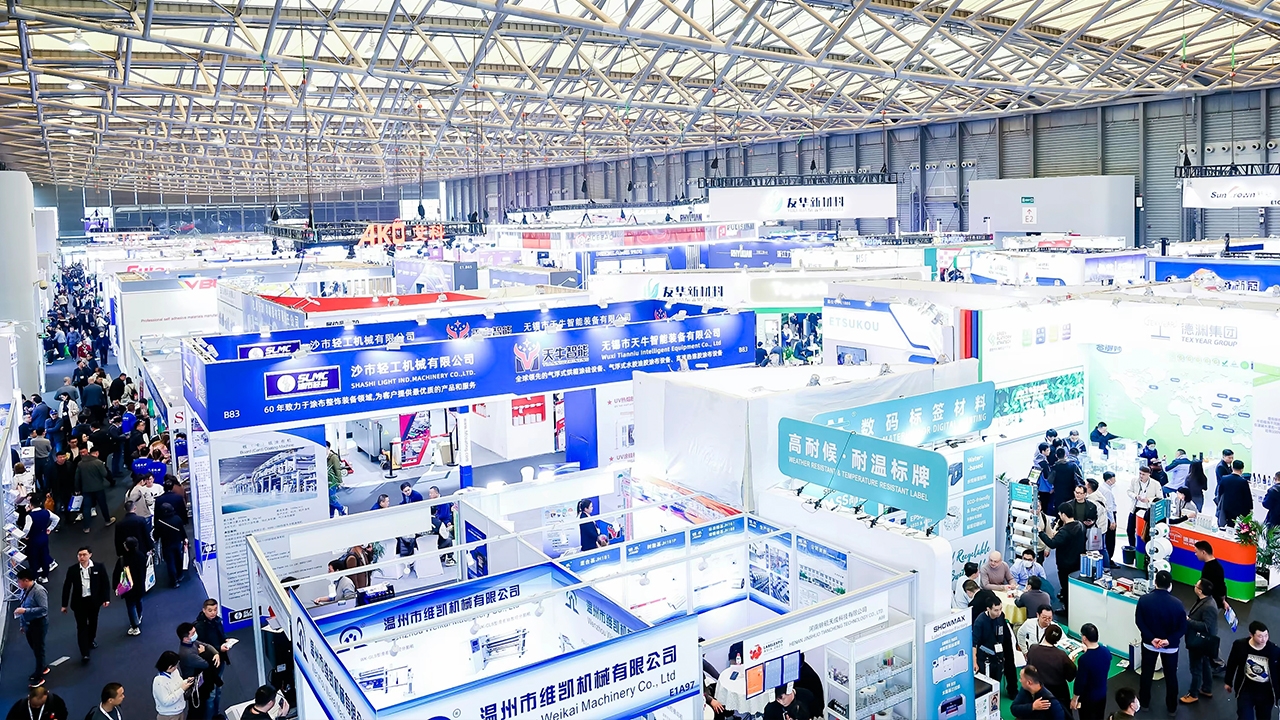
Labelexpo Asia celebrated its 20th anniversary at the SNIEC exhibition center in Shanghai in December, providing a showcase for the Chinese machine manufacturing industry and introducing new international technology to the country’s converters.
Now the second biggest Labelexpo show in the world, Labelexpo Asia boasted a total exhibition area of more than 32,000sqm with more than 380 exhibitors, including over 100 new companies.
Highlights of the show included new launches across digital printing technology, hybrid printing technology, flexo/offset printing technology for label and flexible packaging printing, automatic production processes for pre-press, printing and post-press, as well as sustainable inks, adhesives, self-adhesive materials and RFID.
Digital printing
New digital technology launches were a highlight of this year’s exhibition. As well as international suppliers, including HP Indigo, Durst, Konica Minolta and Epson, there were launches from domestic brands, including Weigang, Flora, Pulisi, Label Source, Haotian, KingT, Vorey, General Inkjet and others.
HP not only displayed an HP Indigo 6K and HP Indigo 25K press on site but also demonstrated the new HP Indigo 200K online for the first time in the Chinese market. The HP booth featured selected user case studies across different market segments.
‘In addition to digital label and packaging presses, HP has many technologies, such as a complete set of anti-counterfeiting and variable data solutions,’ says Roy Xu, HP’s Greater China industrial print general manager.
Xu says the HP Indigo 200K digital press is mainly aimed at flexible packaging applications, particularly for label converters looking to diversify into the flexible packaging market.
‘Digital printing is not looking to replace the traditional CI flexo packaging market,’ adds Xu. ‘We have used the technical experience accumulated in the label printing field to expand to the high-potential short-run flexible packaging market.’
Durst demonstrated its Tau 330 RSC E press, the entry-level press to the Tau range with the same print engine imaging at 1,200 x 1,200 DPI. The press comes as standard with CMYK+ high opacity white, but can be upgraded to CMYK+OVG+W. The company also introduced its Hawk Eye automated print quality control system to the China market.
Shares Lynn Pan, deputy general manager of Durst China: ‘Durst closed three orders on site, among which the Shandong Golden Realm label company ordered its third Durst digital press. At the last Labelexpo Asia in 2019, the company signed the first Durst digital printing press.’ Durst has now sold eight presses in China.
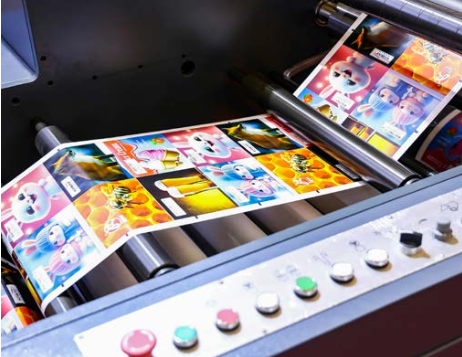
Konica Minolta launched its AccurioLabel 400 toner-based digital label press, now with an additional white station (CMYK+W). The machine prints at up to 39.9m/min with a print resolution of 3,600 x 2,400 DPI. It is fitted with automated color management and the IQ-520 automatic intelligent
quality monitoring system. Also on display was the established AccurioLabel 230 4-color digital label press, launched in 2019, which prints at 23.4m/min with 3,600 x 1,200 DPI resolution.
Epson displayed its desktop digital printing technology — including the CW-C6530, CW-C6030, TM-C7520G, TM-C3520 machines — and its two main industrial label printing presses, the SurePress L-4733AW water-based and SurePress L-6534VW UV inkjet press.
Weigang launched its first digital press, the WG S350, which can be supplied as a standalone system or configured as a fully hybrid machine (ZJR S350 Pro) with integrated flexo print units for pre-coating, solid colors and varnishing, including in-line die-cutting.
The color engine of the Weigang WG S350 uses Epson S3200 printheads with a maximum resolution of 1,200 × 600 DPI, reaching speeds up to 55m/min speed at 600 × 600 DPI. The ZJR S350 Pro can be configured with up to 10 colors, typically CMYK+white, varnish and spot colors.
‘After years of development, Weigang has become the leading conventional press supplier in China,’ says Zhou Xiang, general manager of Weigang. ‘This is the first time we have launched digital printing equipment, which is an important area we want to explore in the future.’
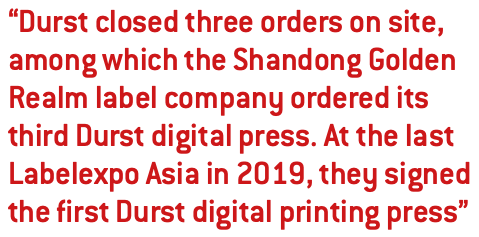
Flora launched its J-350 Pro digital press in a 6-channel configuration which includes dual white channels along with CMYK. This supports both pre- and post-white for printing on transparent materials. A digital varnish is also available. The J-350 Pro is upgradable to a fully hybrid configuration with the addition of flexo units for a wide range of applications, including coating, varnishing and laminating.
The Flora J-350 Pro features a new interface with industry 4.0 capabilities allowing for real-time analysis of completed orders, printed area and ink consumption.
Pulisi showed its Aobead DPIM-330F digital press, available in widths from 220mm-520mm. The press can be configured with multiple flexo units before and after the digital print engine, allowing, for example, digital printing onto cold foil. Other modules include lamination, die-cutting, waste stripping and web inspection with defect detection which can be integrated into an MIS. The 8-color digital engine (CMYK+WOGV) can also jet a digital varnish.
The company has now sold 120 presses into 25 overseas markets.
‘Since its official release in 2021, there are now 120 units installed in the label printing market,’ Olive, general manager of Pulisi tells L&L. ‘In addition to domestic users, we also have installations in the US, Russia, Mexico, India, South Korea and Malaysia. Some of them ordered their second or third machine soon after purchasing their first Aobead press.’
Label Source demonstrated its LabStar 330S hybrid UV inkjet press, manufactured in cooperation with HanGlobal. The machine runs at 50m/min in 7 colors at a resolution of 600 DPI. The
press can be configured with flexo pre-coating, inkjet varnishing, embossing and hot foil stamping modules, along with cold foil, flexo varnishing and semi-rotary die-cutting.
Haotian announced a strategic collaboration agreement with Xaar at Labelexpo Asia 2023 with the launch of the HTP-220/330 digital label embellishment machine. Incorporating Xaar’s 2002 printheads, the HTP-220/330 handles graphics, foil and embossing in a single process.
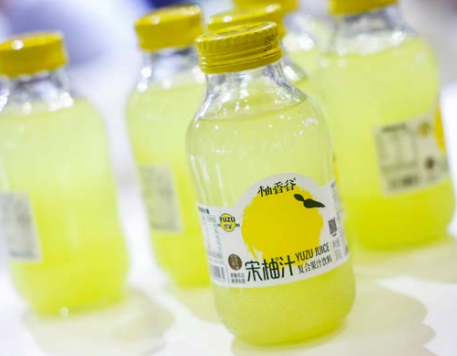
Zeng Baixian, general manager of Haotian, says: ‘We’re delighted to partner with Xaar. The 2002 printhead provides the reliable performance and versatility our customers need to boost their production efficiency and print quality. We believe this collaboration will contribute significantly to the growth of the label printing industry.’
First-time exhibitor KingT launched its L-Press 330s single-pass digital inkjet press, using Fujifilm Samba printheads. The press is available in a 330mm print width with a native resolution of 1,200 x 1,200 DPI, 2pl ink drop and reaching speeds of 80m/min. It can print 95 percent of the Pantone color range.
Vorey showed its Colorjet H3 wide format digital press, using water-based inkjet technology with a print speeds between 10 and 36m/min.
First-time exhibitor General Inkjet Printing launched its Label Smart 216s digital press designed for small-format digital printing and personalized full-color inkjet coding. The Label Smart 216S features an integrated Agfa Apogee pre-press workflow system and is suitable for a variety of materials including film, label stock, tube laminates and papers. Maximum print width is 216mm.
Conventional printing
In terms of exhibition area, conventional label printing equipment still dominated Labelexpo Asia.
In the China label printing market, there has been a major shift in the last 10 years from narrow web letterpress to intermittent offset technology, and today those offset manufacturers are diversifying into in-line flexo presses.
Chinese suppliers showing flexo press technology included Weigang, Taiyo, Zonten, Spande, Hongsheng, Label Source, Qianrun, Caisheng, Jingle and Ako. A trend towards the use of fully servo-driven presses with high levels of automation was evident.
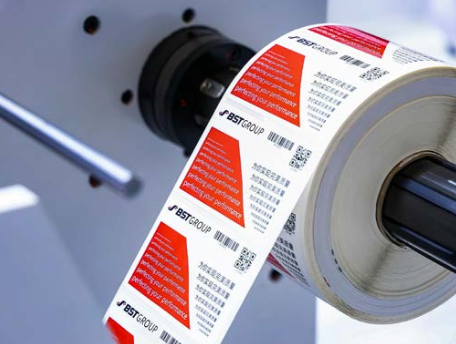
Weigang, for example, demonstrated its latest ZJR-350 flexo press, driven by state-of-the-art German servo control technology, with a total of 23 servo motors for an 8-color machine, enabling features including full auto registration.
The press uses lightweight sleeves for the printing plate, leading to faster changeover and more stable print quality. The press is equipped with chilled anvil rolls to handle a wide range of film materials including PET, OPP, CPP and PP.
Taiyo showed its servo-driven in-line STF-340 flexo press, equipped with chill drums to handle materials from 20-300 microns, including PE, PP and PET film and composites and paper-based PS laminates. The press includes rail-mounted cold stamping and laminating units, a turnbar and rotary screen unit. The machine can also be equipped with rotary die-cut unit, sheet cut unit, backside slitting, folding unit and online inkjet printer.
Spande showed its S5 series flexo press for the first time, designed to produce labels and unsupported films. Each print unit has independently driven plate cylinder, anvil roller and anilox roller and the press has a servo-driven closed loop tension control system.
‘We launched our S7 series flexo press in 2019, now updated to the fifth-generation version, but the S7 platform can no longer meet the needs of this growing market,’ says Spande general manager Ye Keqin. ‘Therefore we have upgraded the platform to the S5 series flexo press.’
Also exhibited was the AC 700/800 mid-web in-line flexo press. The 8-color press incorporated a Pantec hot foil stamping unit capable of foiling shrink sleeve labels – a first in this market.
Zonten launched its modular Smart 420/560/680 press system, printing at up to 150m/min. The machine is platform-based and each unit can be changed between offset, flexo, screen, gravure, varnish and lamination. The cold foil unit can be moved to any position on the press via a rail mount. The machine is servo-driven, equipped with automatic registration and pre-registration systems, second pass sensor and turn bar. The substrate range is from 0.04 to 0.35mm, with chilled anvil rolls to increase the range of materials from unsupported film and metallic foil, PS labels and flex pack.

Zonten also demonstrated its ZTR-330/430/560/680 UV flexo press using Rexroth servo control drives throughout. The press has chilled rollers for printing unsupported film and is equipped with corona, double-sided web cleaning and BST inspection system.
Hongsheng showed the HSR-340, the company’s latest in-line flexo press, available in widths from 340mm to 650mm with a maximum speed of up to 200m/min. A wide range of materials including 12-micron PET, PVC, BOPP, aluminum, paper and paperboard material can be handled.
Hontec showcased its new FlexiCon 8-color in-line flexo press, specifically designed for printing on shrink sleeves as well as standard label materials.
The machine is fully servo-driven and CE-certified and has additional options including cold-foil, hot-stamping, re-lam/ de-lam and turn bars.
Label Source demonstrated the YTP-F6 fully servo-driven in-line flexo press with automatic pre-registration and running register control. The press includes in-line non-stop unwinding and rewinding to save waste and improve productivity.
Qianrun presented the Dowell SF370 flexo press, which has been newly upgraded and optimized. Jingle exhibited their JZ-370A flex press, which is suitable for paper and film (PET, OPP, CPP, PP).
Intermittent offset
Another key trend in the conventional press market was the continued development of intermittent offset printing technology.
Wanjie launched its WJPS-450 shaftless offset press which can be switched between intermittent and full rotary modes. Each print unit consists of 11 servo motors which makes ink delivery and materials handling smoother and more accurate compared to shaft-driven technology. Each printing unit has a chill drum that allows a wide range of film and heat-sensitive materials to be run.
In full rotary mode, the press runs at speeds up to 200m/min for longer run work. In intermittent mode, one set of print cylinders is sufficient to run any job format. This method is the best choice for small and medium-sized orders. The press can also be configured with flexo, screen printing, gravure, hot stamping, cold stamping and variable information modules.

Zonten showed its ZTJ-330/520/680 servo-driven intermittent offset press complete with auto and pre-register, with a total of 23 inking rollers per unit, including four plate inking rollers.
Labelmaster launched its LM350 intermittent UV-offset press, which can optionally be configured with a flexo varnish station, inspection, cold foiling, rotary die-cutting, waste rewinding and slitting.
Nickel showed its FS350/520 intermittent offset press, controlled by an American Lattice control system with 19 ink rollers including four plate inking rollers and four water rollers, which effectively prevents ghosting. Each printing unit is Labelexpo Asia 2023 | 67 equipped with an independent registration system.
Materials
For materials exhibitors, sustainability was a key theme. Avery Dennison, for example, set up a sustainability area on its booth to showcase a new carbon footprint measurement tools and materials that allow packaging to be recycled or reused. The company also demonstrated rPP and rPE facestocks containing 30 percent post-consumer recycled material and rPET facestocks containing 100 percent recycled resin.
Fedrigoni showed Re-Play, a new range of self-adhesive materials manufactured using upcycled siliconized liner waste. The first of these products are four white papers with 10 percent glassine content, available in natural, embossed, pearl and neck label versions. All papers carry a certificate specifying their composition and their value as a recycled and sustainable product.
Re-Play’s final carbon footprint is claimed half that of a virgin paper-based product with the same performance features. This is a genuine revolution, a tangible example of upcycling, where the final material has a higher value than the original material.
As the sponsor of the floorplan map, Yupo showcased in-mold materials including PET IML material, 3D materials and high-end metalized IML materials. Yupo also showcased its sustainability efforts, including synthetic paper using biomass resins which effectively reduce greenhouse gas (CO2) emissions.
Lintec demonstrated its polyester-based adhesives, which means that PET containers decorated with PET labels and this new adhesive are effectively mono-material packaging that can be recycled without having to remove the label or adhesive. This product won the Innovation Category (over 300 employees) in the Label
Industry Global Awards 2023 presented at Labelexpo Europe.
Jinda claims to be China’s biggest domestic manufacturer of pressur-sensitive labels with four coating facilities. The company was focusing on sustainability, now using up to 50 percent PCR materials in its film labelstocks. The company says the recyclate is certified to European standards. Key trends seen by Jinda include an increasing use of PS film and a rapid increase in the number of automated applicators at end users. The company also has a linerless label product for the logistics industry under development.
Another major materials trend at Labelexpo Asia 2023 was intelligent label technology displayed in the Smart Label Trail special show feature.
The rapid development of the Internet of Things (IoT), intelligent manufacturing and new self-checkout retail formats has driven an increasing demand for UHF (ultra-high frequency) RFID labels. The Smart Label Trail gave converters an overall insight into RFID technology trends and practical applications and how to set up their own RFID converting operation.
A range of suppliers exhibited on the Smart Label Trail, including Avery Dennison, Muehlbauer, Voyantic, Yuanmingjie, Hadesheng, Chili, Taibao, HOACO, Shanghai Jinglu, Chankey, XGSun, OSRFID, ADA, Postek, Leidan, Summation Solutions, HWA-TECH, Wing Singa and Sdiot.
They demonstrated products, technologies, and services related to the entire process of RFID label manufacturing, including cutting-edge chip technology, smart label materials, smart label converting equipment, inspection and QA systems and desktop printing/programming equipment.
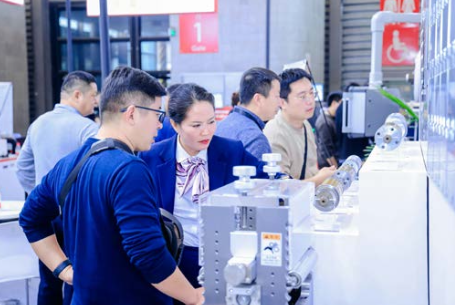
At the same time, the RFID Smart Label and Anti-counterfeiting Traceability Innovation Forum was held with China’s Security Identification Union (SID), further focusing attention on the development and application of smart labels.
Finishing technology
The trend to digitization in the labels industry is not only happening in the printing industry but also in the finishing process. Labelexpo Asia 2023 saw the introduction of a wide range of laser die-cutting technology.
SEI Laser introduced the latest version of its Labelmaster converting system, available in roll widths of 350mm and 600mm.
This is a fully modular system suitable for roll-to-roll and roll-to-sheet converting, laser die-cutting and finishing.
The machine has a wide range of applications including the production of self-adhesive labels and flexible packaging. QR/ barcode reading systems allow instant change between jobs, eliminating setup time.
This fourth-generation Labelmaster is equipped with a KyoJet digital printer system and four laser heads, giving a maximum speed of up to 100m/min dependent on cutting pattern, in some cases matching the productivity of traditional die-cutting and finishing systems.
Golden Laser showed its LC350 intelligent high-speed laser die-cutting machine, which adopts multi-head laser technology and can reach speeds up to 120m/min depending on material and cutting pattern.
Shengye displayed its SR360 roll-to-roll laser die-cutting machine with a beam diameter down to 0.2mm, while Jingwei debuted its RSF-360 laser die-cutting machine, capable of operating at up to 60m/min.
Digital embellishment is a growing application in the China market, and systems were demonstrated by a range of suppliers.
Kurz showed its digital transfer metallization systems. The company supplies complete packages including digital machine modules, transfer coatings, customized inks and efficiency- boosting software.
Brotech showed its iDM 330 digital embellishment system, a multifunctional machine that supports the application of high opacity digital white, digital metallization and digital varnish. The machine can handle variable data, 2D barcodes, and braille.
Brotech also launched its SDF Hybrid 370 converter in the Asia-Pacific region.
This is a platform-based system that incorporates a rotatable hot foil unit which can be switched between horizontal and vertical foil stamping directions with a maximum pressure of up to 45 tons.
The system at the show also incorporated a flatbed screen and a flexo unit. Both laser and conventional die-cutting modules can be selected, and there is a rail mounting system for additional processing.
The SDF PLUS can also be customized with a digital embellishment unit, including digital white ink and digital foil stamping.
This was the first demonstration of equipment resulting from the acquisition of France-based Smag by Rhyguan. On display was a range of equipment including the Plus-330 line designed to finish digitally printed labels with high-quality embellishments including digital foil and high build digital varnish. It is suitable for ultra-short-run jobs, personalized labels and high-end security applications.
Reborn showed its 370mm-wide RJB-Remix 3DW UV digital embellishment equipment operating at speeds up to 50m/min. The Remix utilizes Ricoh G5 inkjet heads configured in two rows of six heads to jet both varnish and adhesive for digital foil applications.
Sapa demonstrated its DMS-W and DMS-S digital foil machines. The DMS-W operates in roll-to-roll mode at up to 50m/min on a 330-1050mm width, while the DMS-S operates in single sheet mode at up to 3,000 sheets/hour speed and 390-1050mm width.
Along with the digital embellishment systems was a wide range of conventional die-cutting/slitting/inspection machines.
Vorey displayed its VD3350II Max, an intelligent high-speed label die-cutting machine with dual stations and 12 slitting blades achieving a fast job change in 10 seconds and with a cutting speed of 18m/m.

Reborn demonstrated its RBJ-Azure 370 multi-function finishing machine, including semi-rotary flexo printing, screen printing, flatbed hot stamping/embossing and rotary die cutting. The modular design allows converters to match the system to their converting requirements.
Darui showed its S4 digital die-cutting machine, with eight slitting blades which can be easily configured to run inline with a digital press, and Koyo displayed its digitally controlled cutting machine.
Luster Light Tech demonstrated its Labelhero Series inspection system designed to support critical applications including variable code inspection, color monitoring and PDF proofing. It can integrate with different types of production workflows.
The company is investing significant resources in AI development for the next generation of inspection systems at its impressive new R&D facility.
Stay up to date
Subscribe to the free Label News newsletter and receive the latest content every week. We'll never share your email address.

